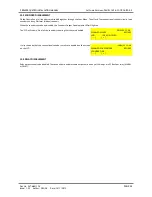
PREMIER QUATRO INSTALLATION MANUAL
Software Versions: PANEL 1.52 & LOOP CARD 2.0
Doc No. GLT.MAN-134
PAGE 19
Issue: 1.33 Author: GW/NJ Date: 14/1/2013
8. SOUNDERS AND OUTPUTS
The Sounders* in Sections 8.1 to 8.5 can be directly or indirectly connected to one of the 4 loops on Premier Quatro:
8.1 ADDRESSABLE STAND-ALONE SOUNDERS
This type of sounder takes one of the 125 addresses available on each loop. The address is selected via DIP switches 1 to 7. It can be
activated individually, or in groups related to its zone number, loop number or panel number (as determined by the cause and effect
programmed). An example of this type of sounder is the Zeta Maxitone Addressable Sounder
8.2 ADDRESSED SOUNDER BASE
This consists of an addressable sounder in the base of an addressable detector. The sounder and detector are set to different
addresses, i.e. two devices are located at the same position on a loop but occupy two addresses. The correct operation of the dual-
addressed detector / sounder combination requires that DIP switch 8 of the sounder must be ON. A Securetone 2 Sounder can be
used as an addressed sounder base or, with the detector removed, as a stand-alone addressable sounder.
8.3 ASSOCIATED SOUNDER BASE
There are 2 types of associated sounder base:
a)
This is the same combination of base sounder and detector as in 8.2 above, but this time DIP switch 8 is switched OFF, and
the address of the sounder in the base must be set to be the same as that of the detector. In this case the sounder is
hidden from the panel, as it does not have its own address, and the sounder will remain silent until the panel is told of its
presence. To tell the panel that a detector has an associated sounder, follow the commands that configure a detector’s
remote indicator (see Section 11.10). The sounder will now operate when the START SOUNDERS button is pressed, or
when the corresponding detector’s address is part of a “cause & effect” output.
b)
There is another kind of base sounder which interfaces with a conventional detector. This is called the Securetone Micro
Addressable Sounder. It contains DIP switches to set its address, and a jumper connector which can be set to either the
smoke detector position or the heat detector position, depending on the type of conventional detector which is
connected. When the detector is triggered, the panel indicates a fire at the address allocated to the sounder, and displays
the type of detector at this address. As with 8.3 a), the sounder will not operate unless the remote output is configured.
8.4 COMMON SOUNDER BASE
The common sounder base is connected to an addressable detector, but does not take the detector’s address. Common sounders
are allocated an address of 126 and are placed in Zone 1. So if the panel is configured to turn on Zone 1 outputs during an alarm, all
common sounders will be activated.
There is also a Loop Common Sounder option. Instead of common sounders on all loops being activated as above, it is possible to
select individual loops for common sounder operation. If switched off, the common sounders on that loop will not sound during an
alarm (see also Section 18.2).
8.5 ADDRESSABLE SOUNDER CIRCUIT CONTROLLER
The Zeta addressable sounder circuit controllers (ZSCC & ZSCC/4) can be used to connect one or four conventional sounder circuits,
respectively, to one address on the loop. It needs external power to be supplied from a suitable 24 V power supply.
8.6 PCB CONVENTIONAL SOUNDER CIRCUITS
The terminations PCB has 2 conventional sounder circuit outputs, with a maximum capacity of 450 mA each. Please note that
conventional sounders should be wired as shown in the diagram below:
*The descriptions of sounders in this section also apply to flashers and combined sounder / flashers.






























